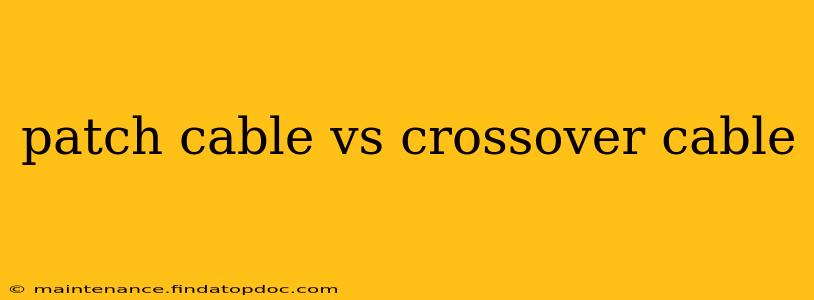Patch Cable vs. Crossover Cable: Understanding the Differences
Choosing the right cable for your networking needs can be confusing, especially when faced with the seemingly similar options of patch cables and crossover cables. While both are used to connect network devices, they serve distinct purposes and have different wiring configurations. This article will clarify the differences between patch cables and crossover cables, helping you choose the appropriate cable for your specific situation.
What is a Patch Cable?
A patch cable, also known as a straight-through cable, is the most common type of Ethernet cable used for connecting network devices. It features a standard wiring arrangement where pins 1-8 on one end directly correspond to pins 1-8 on the other end. This simple configuration makes it ideal for connecting a computer to a switch, router, or other network devices. The switch or router handles the necessary data translation for communication.
What is a Crossover Cable?
Unlike a patch cable, a crossover cable has a reversed wiring scheme. Specifically, transmit (TX) and receive (RX) pairs are swapped. This means the transmit pins on one end are connected to the receive pins on the other end, and vice versa. This configuration is crucial when directly connecting two similar network devices, such as two computers or two switches, without the need for a central networking device like a hub or switch to manage the data flow.
Patch Cable vs. Crossover Cable: A Detailed Comparison
| Feature | Patch Cable (Straight-Through) | Crossover Cable |
|---|---|---|
| Wiring | Straight-through wiring (pins 1-8 correspond) | Crossover wiring (TX and RX pairs are swapped) |
| Use Case | Connecting a computer to a switch, router, etc. | Connecting two similar devices directly (computer-to-computer, switch-to-switch) |
| Modern Relevance | Primarily used for most networking connections. | Less frequently needed due to auto-MDIX technology. |
| Auto-MDIX Compatibility | Works with Auto-MDIX enabled devices. | Works with Auto-MDIX enabled devices (but usually unnecessary) |
What is Auto-MDIX?
Auto-MDIX (Automatic Medium-Dependent Interface Crossover) is a crucial feature built into most modern networking devices (switches, routers, and even some network interface cards). This technology automatically detects the type of cable connected and adjusts the wiring configuration accordingly. This means you typically only need patch cables, as the device will handle the crossover function if needed.
When Would You Need a Crossover Cable?
While auto-MDIX has significantly reduced the need for crossover cables, there might still be niche situations where you'd encounter them:
- Older Network Equipment: Very old network devices might not support Auto-MDIX, requiring a crossover cable for direct connection.
- Specific Industrial Applications: Certain industrial or specialized network setups might still use crossover cables due to compatibility issues or legacy systems.
How to Identify a Patch Cable vs. Crossover Cable?
Visually identifying the difference between a patch cable and a crossover cable is difficult. The easiest way to tell them apart is by testing them with network devices, or by using a cable tester. However, due to Auto-MDIX, simply using a patch cable will often work in most cases.
Which Cable Should I Use?
In almost all cases, for modern networking, you should use a patch cable. The widespread adoption of Auto-MDIX makes crossover cables largely obsolete for most users. Only if you're working with very old equipment or a specific industrial setting might you need a crossover cable. If you are unsure, always start with a patch cable.
This guide aims to provide a comprehensive understanding of the differences between patch cables and crossover cables. While crossover cables were once essential, the advancements in networking technology, especially Auto-MDIX, have significantly reduced their necessity. Understanding this distinction empowers you to confidently select the appropriate cable for your networking setup.
